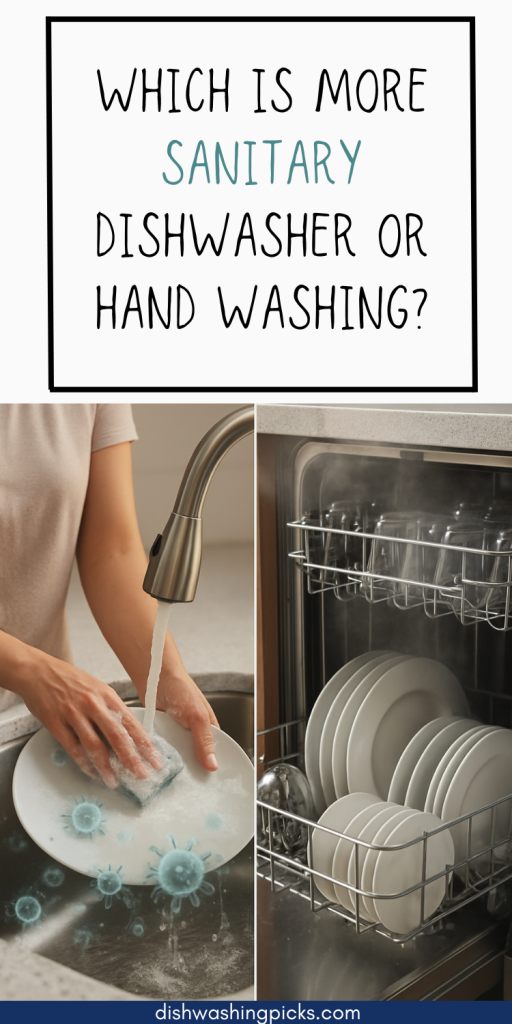
Dishwasher vs. Hand Washing – The Germ Battle Begins
Ever found yourself standing at the sink, sponge in hand, thinking, “Is this really cleaner than just tossing it in the dishwasher?” You’re not alone. There’s an ongoing kitchen debate about which is truly more sanitary—good ol’ hand washing or letting the machine do the work.
Now, before we roll up our sleeves (or hit that Start button), let’s break it down. Spoiler: it’s not just about the soap you use or how long you scrub. It’s about bacteria, temperature, and even your sponge. (Yeah, that sponge may not be as innocent as it looks.)
Ready to dive in? Let’s get squeaky clean on the facts.
The Temperature Test: Who Brings the Heat?
Here’s the thing: dishwashers are literal hot zones. Most models reach temps between 130°F to 160°F (that’s too hot to handle with bare hands). And those high temps? They’re designed to sanitize.
Now think about hand washing. How hot is your tap water, really? Most people don’t (and can’t) wash dishes with water above 110°F—anything higher and you’re risking scalded hands. That’s warm, but not sanitize-your-fork warm.
Try thinking of it this way: If bacteria had a preference, they’d definitely avoid the dishwasher’s hot rinse like the plague. In terms of pure heat-based cleanliness, dishwasher takes round one.
The Germy Truth About Sponges
Imagine this: you’ve just washed your plate with a sponge that’s been sitting by the sink for a few days. It looks fine, but here’s a gross fact—kitchen sponges are among the dirtiest things in your home.
Studies have found that they can harbor E. coli, salmonella, and a party of other nasty bacteria. Dishwashers, on the other hand? No sponge required. Just racks, jets, and heat.
So unless you’re replacing your sponge daily (which, let’s be honest, most of us aren’t), the dishwasher wins the hygiene round again.
Soap Strategy: Manual vs Machine
Alright, let’s talk suds.
Hand washing usually relies on dish soap and elbow grease. That’s not bad—it can break down grease effectively, especially when used with hot water and a fresh sponge. But here’s the deal: dishwashers use detergent specifically formulated to remove grime and sanitize in a high-temp environment.
Plus, many modern machines have a sanitize cycle, which meets National Sanitation Foundation (NSF) standards for killing bacteria.
If it’s a true sanitation showdown, the dishwasher’s got backup.
Real World Results: Which Method Leaves Fewer Germs?
Here’s where it gets interesting. A number of studies—including those from hygiene research groups and appliance makers—show that dishwashers consistently leave dishes with fewer bacteria than hand washing.
Even when people are super thorough, hand washing still leaves more germs behind. Why? Because of inconsistent water temperature, reused sponges, and just plain human error.
Still think your scrubbing skills can compete? Let’s test it: wash a plate by hand and then run a bacteria swab test. Now do the same with one from the dishwasher. You might not like the results…
Exceptions to the Rule: When Hand Washing Wins
Okay, to be fair—there are moments where hand washing might be the better choice. Think:
- Delicate wine glasses
- Wooden utensils
- Cast iron pans
- Super dirty pots that need soaking
Also, if your dishwasher is ancient and lacks a sanitize cycle, it might not beat a good hand scrub every time. So yes, context matters.
The Final Verdict
So… what’s the cleaner choice?
For most people, most of the time, dishwashers win the sanitation game hands down. They’re hotter, more consistent, and just plain better at blasting away bacteria.
But hey—there’s still a place for hand washing. Just be smart about it: use hot water, fresh sponges, and air dry everything if possible.
